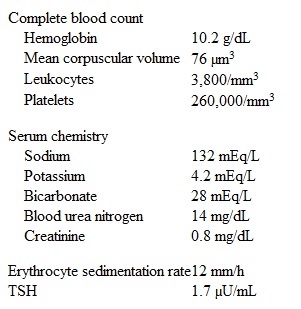A 36-year-old man comes to the office due to frequent "loose stools" for the past 10 months. The patient describes stools that are large in volume, liquid to semisolid, occurring up to 3-4 times a day, and often foul-smelling. He also reports excessive flatulence and occasional nausea and abdominal cramping. The patient says he may have lost some weight because his clothes are much looser than before. He has no prior medical problems and takes no medications. Family history is notable for hypertension and coronary artery disease in his father. The patient immigrated to the United States from Italy with his family when he was 2 years old and has not traveled out of the country since then. He does not use tobacco or illicit drugs and drinks alcohol occasionally. The patient works in a family-owned restaurant and has had no sick contacts. He consumes a balanced diet and notes no specific association of diarrhea to food. The patient has been in a monogamous relationship with his wife for the past 10 years. Temperature is 36.6 C (97.9 F) , blood pressure is 130/86 mm Hg, and pulse is 72/min. Weight is 63.5 kg (140 lb) . The sclerae are anicteric, and mucous membranes are moist without any lesions. Cardiopulmonary examination is unremarkable. The abdomen is soft, nondistended, and nontender, with no organomegaly. Bowel sounds are increased. Rectal examination shows no masses or tenderness and an empty rectal vault. Stool occult blood testing is negative. Samples for blood count, erythrocyte sedimentation rate, TSH, and serum electrolytes are obtained. The patient comes for a follow-up visit 2 weeks later. He continues to have large-volume, foul-smelling stools but has had no new symptoms. The patient recollects that his weight was about 75 kg (165 lb) prior to the onset of symptoms, and he has lost more than 5 kg (11 lb) . Physical examination findings are unchanged. Laboratory testing performed during the previous visit is notable for the following:  Stool studies revealed a high osmotic gap. Further laboratory studies are ordered. Gastrointestinal endoscopy with biopsy is most likely to reveal which of the following?
Stool studies revealed a high osmotic gap. Further laboratory studies are ordered. Gastrointestinal endoscopy with biopsy is most likely to reveal which of the following?
Definitions:
Competing Companies
Businesses operating in the same industry or market that offer similar products or services to the same customer base.
Proximity
The state or quality of being near or close in space or time.
Centre-of-Gravity
A method used in logistics and supply chain management to determine the best location for facilities based on minimizing transportation costs, considering the locations of suppliers, customers, and other factors influencing the total cost.
Quantitative Methods
A systematic empirical investigation of observable phenomena via statistical, mathematical, or computational techniques.
Q149: A 3-month (91-day) UK Treasury bill with
Q171: What does the Model Code say about
Q386: An older-appearing man of unknown age is
Q423: The premium on an option contract is:<br>A)
Q594: If the value date of forward USD/JPY
Q675: A 45-year-old man comes to the clinic
Q720: As part of a study on treatment
Q894: A 42-year-old man comes to the emergency
Q938: A 79-year-old man is brought to the
Q989: A 26-year-old woman comes to the clinic